线程概述

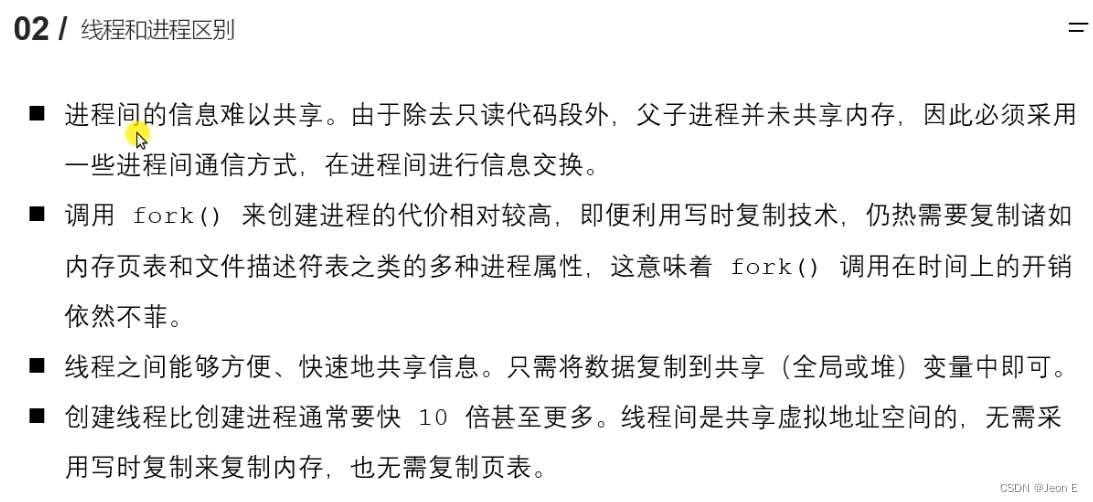
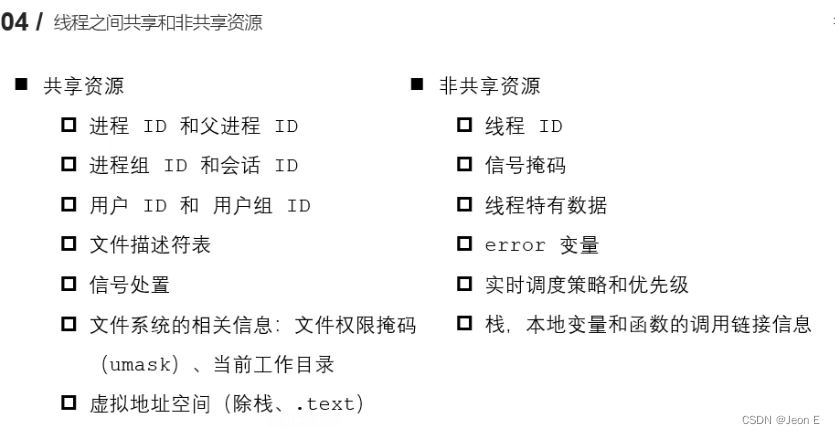
创建线程
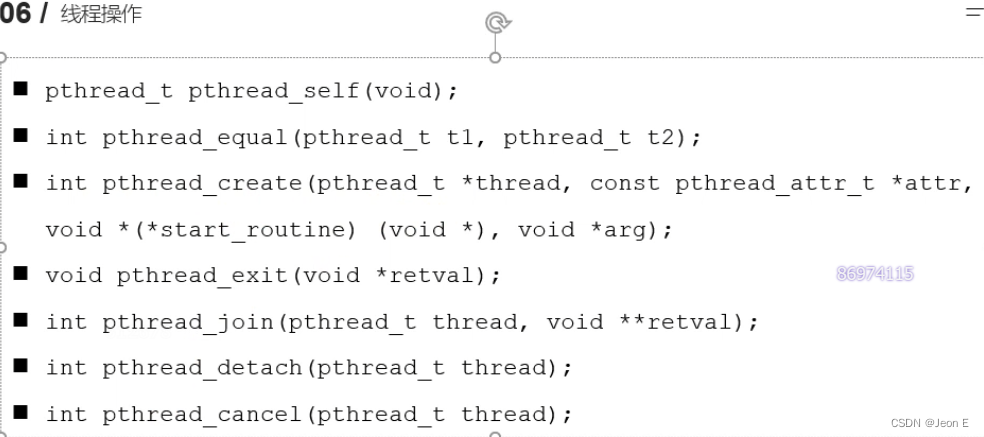
与线程相关的,编译和链接时需要-pthread或者-lpthread
pthread_create
//一般情况下,main函数所在的线程称之为主线程(main线程),其余创建的称之为子线程
//程序中默认只有一个进程,fork()函数调用,2个进程
//程序中默认只有一个线程,pthread_create()函数调用,2个线程
//需要头文件
#include <pthread.h>
//函数原型
int pthread_create(pthread_t *thread, const pthread_attr_t *attr, void *(*start_routine) (void *), void *arg);
/*
功能:创建一个子线程
参数:
-thread:传出参数,线程创建成功后,子线程的线程ID写入到该变量中
-attr:设置线程的属性,一般使用默认值,NULL
-start_routine:函数指针,这个函数是子线程需要处理的逻辑代码
-arg:给第三个参数使用,传参
返回值:
成功:返回0
失败:返回错误号,这个错误号和之前的errno不太一样
获取错误号信息:char* strerror(int errnum);(string.h)
*/
示例
#include<stdio.h>
#include <pthread.h>
#include<string.h>
#include<unistd.h>
void* callback(void* arg)
{
printf("child thread...\n");
printf("arg value : %d\n",*(int*)arg);
return NULL;
}
int main()
{
//创建一个子线程
pthread_t tid;
int num = 10;
int ret = pthread_create(&tid,NULL,callback,(void*)&num);
if(ret != 0)
{
char* errstr = strerror(ret);
printf("error : %s\n",errstr);
}
for(int i=0;i<5;i++)
printf("%d\n",i);
sleep(1); //等待一下子线程执行
return 0;
}
gcc pthread_create.c -o pthread_create -pthread
终止线程
pthread_exit
//需要头文件
#include <pthread.h>
//函数原型
void pthread_exit(void *retval);
/*
功能:终止一个线程,在哪个线程中调用,就表示终止哪个线程
参数:
retval:需要传递一个指针,作为一个返回值,可以在pthread_join()中获取到。
*/
//函数原型
pthread_t pthread_self(void);
/*
功能:获取当前的线程的线程ID
*/
//函数原型
int pthread_equal(pthread_t t1, pthread_t t2);
/*
功能:比较两个线程ID是否相等
不同的操作系统,pthread_t类型的实现不一样,有的是无符号的长整型,有的是使用结构体去实现
*/
示例
#include<stdio.h>
#include <pthread.h>
#include<string.h>
void* callback(void* arg)
{
printf("child thread id : %ld\n",pthread_self());
return NULL; //相当于pthread_exit(NULL);
}
int main()
{
//创建一个子进程
pthread_t tid;
int ret = pthread_create(&tid,NULL,callback,NULL);
if(ret != 0)
{
char* errstr = strerror(ret);
printf("error : %s\n",errstr);
}
//主线程
for(int i=0;i<5;i++)
{
printf("%d\n",i);
}
printf("tid : %ld , main thread id : %ld\n",tid,pthread_self());
//让主线程退出,当主线程退出时,不会影响其他正常运行的线程。
pthread_exit(NULL);
return 0;
}
连接已终止的进程
pthread_join
//需要头文件
#include <pthread.h>
//函数原型
int pthread_join(pthread_t thread, void **retval);
/*
功能:和一个已终止的线程进行连接
回收子线程的资源
这个函数是阻塞函数,调用一次只能回收一个子线程
一般在主线程中使用
参数:
-thread:需要回收的子线程的ID
-retval:接收子线程退出时的返回值
返回值:
成功:0
失败:非0,返回的错误号
*/
示例:
#include<stdio.h>
#include <pthread.h>
#include<string.h>
#include<unistd.h>
int value = 10;
void* callback(void* arg)
{
printf("child thread id : %ld\n",pthread_self());
sleep(3);
//return NULL; //相当于pthread_exit(NULL);
pthread_exit((void*)&value); //相当于 return (void*)&value;
}
int main()
{
//创建一个子进程
pthread_t tid;
int ret = pthread_create(&tid,NULL,callback,NULL);
if(ret != 0)
{
char* errstr = strerror(ret);
printf("error : %s\n",errstr);
}
//主线程
for(int i=0;i<5;i++)
{
printf("%d\n",i);
}
printf("tid : %ld , main thread id : %ld\n",tid,pthread_self());
//主线程调用pthread_join()回收子线程的资源
int* thread_retval;
ret = pthread_join(tid,(void**)&thread_retval);
if(ret!=0)
{
char* errstr = strerror(ret);
printf("error : %s\n",errstr);
}
printf("exit data : %d\n",*thread_retval);
printf("回收子线程资源成功!\n");
//让主线程退出,当主线程退出时,不会影响其他正常运行的线程。
pthread_exit(NULL);
return 0;
}
线程的分离
pthread_detach
//需要头文件
#include <pthread.h>
//函数原型
int pthread_detach(pthread_t thread);
/*
功能:分离一个线程,被分离的线程在终止的时候,会自动释放资源返回给系统
1.不能多次分离,会产生不可预料的行为
2.不能去连接(join)一个已经分离的线程,会报错
参数:需要分离的线程的ID
返回值:
成功:0
失败:错误号
*/
示例:
#include<pthread.h>
#include<stdio.h>
#include<string.h>
#include<unistd.h>
void* callback(void* arg)
{
printf("child thread id: %ld\n",pthread_self());
return NULL;
}
int main()
{
//创建一个子线程
pthread_t tid;
int ret = pthread_create(&tid,NULL,callback,NULL);
if(ret != 0)
{
char* errstr = strerror(ret);
printf("error1 : %s\n",errstr);
}
//输出主线程和子线程ID
printf("tid: %ld,main thread id: %ld\n",tid,pthread_self());
//设置子线程分离,子线程分离后,子线程结束时对应的资源就不需要主线程释放
ret = pthread_detach(tid);
if(ret != 0)
{
char* errstr = strerror(ret);
printf("error2 : %s\n",errstr);
}
//设置分离后,对分离的子线程进程连接join
ret = pthread_join(tid,NULL);
if(ret != 0)
{
char* errstr = strerror(ret);
printf("error3 : %s\n",errstr); //输出error3 : Invalid argument
}
pthread_exit(NULL);
return 0;
}
线程取消
pthread_cancel
//需要头文件
#include <pthread.h>
//函数原型
int pthread_cancel(pthread_t thread);
/*
功能:取消线程(让线程终止)
取消某个线程,可以终止某个线程的运行
但不是立刻终止,而是当子线程执行到一个取消点,线程才会终止
取消点:系统规定好的一些系统调用
我们可以粗略地理解为从用户区到内核区的切换,这个位置称之为取消点
*/
示例:
#include<pthread.h>
#include<stdio.h>
#include<string.h>
#include<unistd.h>
void* callback(void* arg)
{
printf("child thread id: %ld\n",pthread_self());
for(int i=0;i<5;i++)
printf("child:%d\n",i);
return NULL;
}
int main()
{
//创建一个子线程
pthread_t tid;
int ret = pthread_create(&tid,NULL,callback,NULL);
if(ret != 0)
{
char* errstr = strerror(ret);
printf("error1 : %s\n",errstr);
}
//取消线程
pthread_cancel(tid);
for(int i=0;i<5;i++)
printf("%d\n",i);
//输出主线程和子线程ID
printf("tid: %ld,main thread id: %ld\n",tid,pthread_self());
pthread_exit(NULL);
return 0;
}
线程属性

//需要头文件
#include <pthread.h>
//函数原型
int pthread_attr_init(pthread_attr_t *attr);
/*
功能:初始化线程属性变量
*/
int pthread_attr_destroy(pthread_attr_t *attr);
/*
功能:释放线程属性的资源
*/
int pthread_attr_setdetachstate(pthread_attr_t *attr, int detachstate);
/*
功能:获取线程分离的状态属性
PTHREAD_CREATE_DETACHED
PTHREAD_CREATE_JOINABLE(默认)
*/
int pthread_attr_getdetachstate(const pthread_attr_t *attr, int *detachstate);
/*
功能:设置线程分离的状态属性
*/
示例:
#include<pthread.h>
#include<stdio.h>
#include<string.h>
#include<unistd.h>
void* callback(void* arg)
{
printf("child thread id: %ld\n",pthread_self());
return NULL;
}
int main()
{
//创建一个线程属性变量
pthread_attr_t attr;
//初始化属性变量
pthread_attr_init(&attr);
//设置属性
pthread_attr_setdetachstate(&attr,PTHREAD_CREATE_DETACHED);
//创建一个子线程
pthread_t tid;
int ret = pthread_create(&tid,&attr,callback,NULL);
if(ret != 0)
{
char* errstr = strerror(ret);
printf("error1 : %s\n",errstr);
}
//获取线程栈的大小
size_t stacksize;
pthread_attr_getstacksize(&attr,&stacksize);
printf("thread stack size : %ld\n",stacksize);
//输出主线程和子线程ID
printf("tid: %ld,main thread id: %ld\n",tid,pthread_self());
//释放线程属性资源
pthread_attr_destroy(&attr);
pthread_exit(NULL);
return 0;
}
线程同步
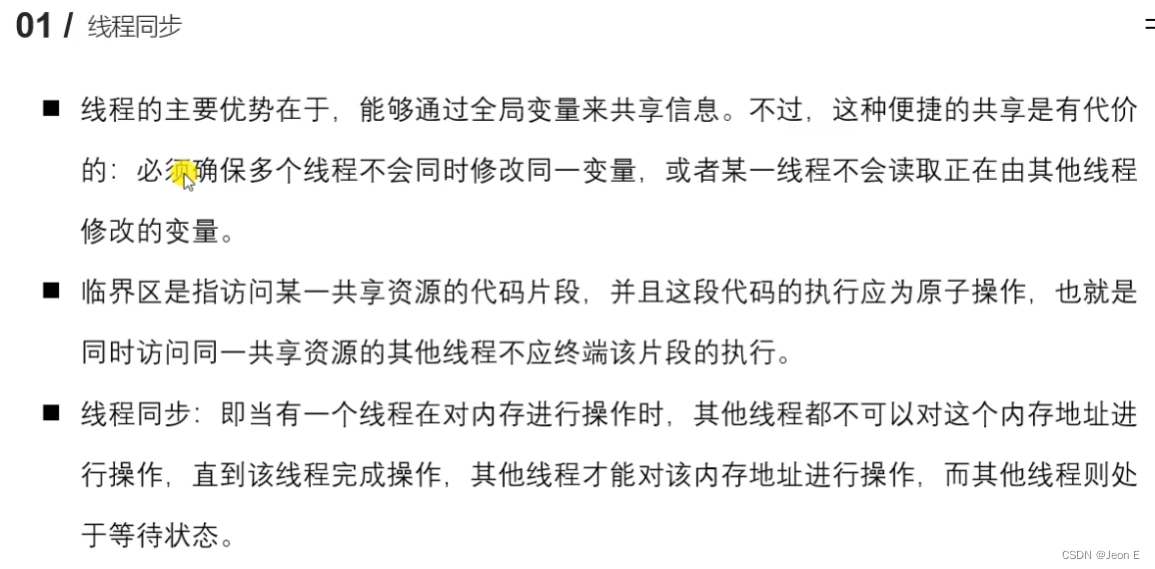
互斥锁
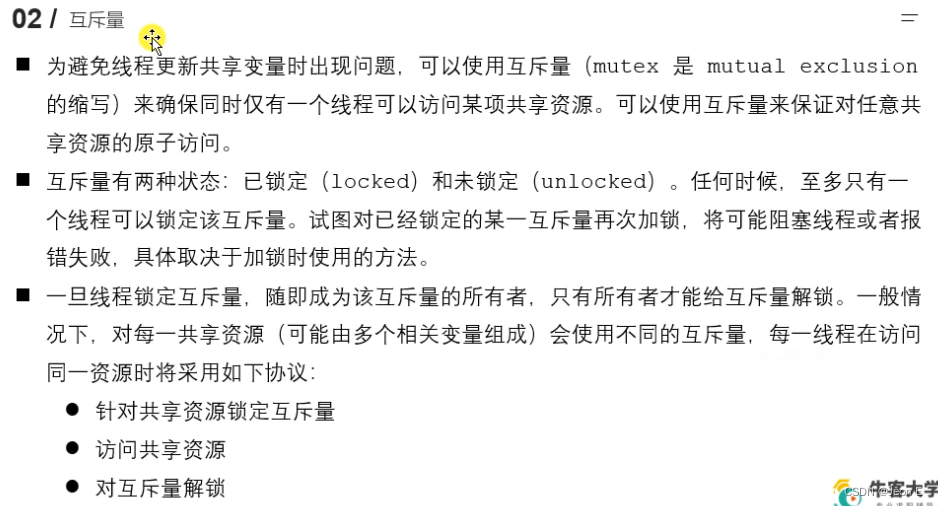
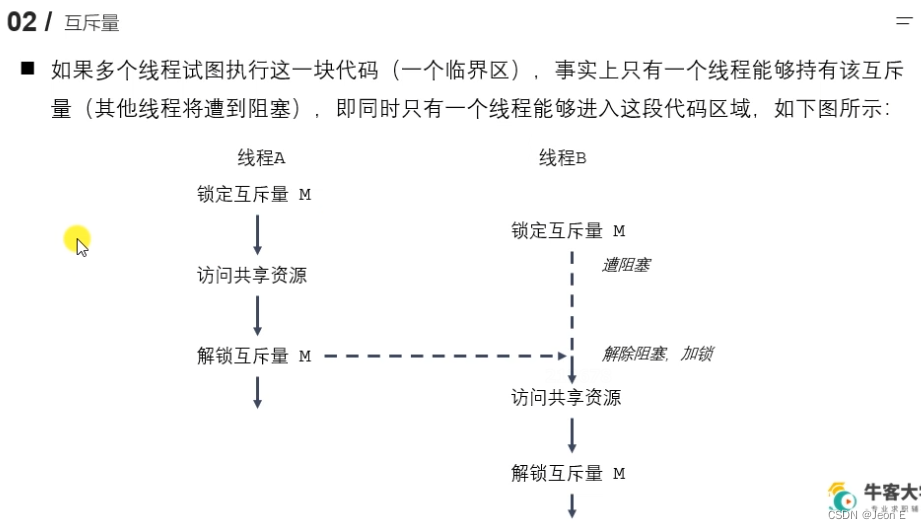
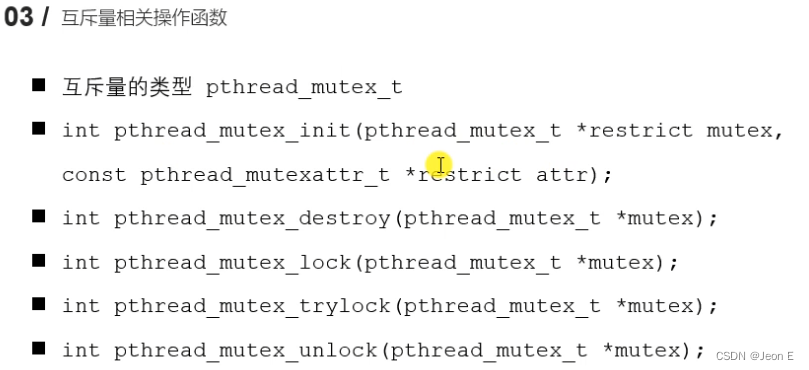
#include<pthread.h>
int pthread_mutex_init(pthread_mutex_t *restrict mutex, const pthread_mutexattr_t *restrict attr);
/*
功能:初始化互斥量
参数:
-mutex:需要初始化的互斥量变量
-attr:互斥量相关的属性,NULL(使用默认的)
restrict:C语言的修饰符,被修饰的指针,不能由另外的一个指针进行操作
*/
int pthread_mutex_destroy(pthread_mutex_t *mutex);
/*
释放互斥量的资源
*/
int pthread_mutex_lock(pthread_mutex_t *mutex);
/*
加锁,阻塞的(如果有一个线程加锁了,那么其他的线程只能阻塞等待)
*/
int pthread_mutex_trylock(pthread_mutex_t *mutex);
/*
尝试加锁,如果加锁失败,不会阻塞,会直接返回
*/
int pthread_mutex_unlock(pthread_mutex_t *mutex);
/*
解锁
*/
示例:
#include<stdio.h>
#include<pthread.h>
#include<unistd.h>
//全局变量,共享资源
int tickets = 1000;
//创建互斥量
pthread_mutex_t mutex;
void* sellticket(void* arg)
{
//卖票
while(1)
{
//加锁
pthread_mutex_lock(&mutex);
if(tickets>0)
{
usleep(6000);
printf("%ld 正在卖第 %d 张门票\n",pthread_self(),tickets);
tickets--;
}
//解锁
pthread_mutex_unlock(&mutex);
}
return NULL;
}
int main()
{
//初始化互斥量
pthread_mutex_init(&mutex,NULL);
//创建3个子线程
pthread_t tid1,tid2,tid3;
pthread_create(&tid1,NULL,sellticket,NULL);
pthread_create(&tid2,NULL,sellticket,NULL);
pthread_create(&tid3,NULL,sellticket,NULL);
//回收子线程的资源,阻塞
pthread_join(tid1,NULL);
pthread_join(tid2,NULL);
pthread_join(tid3,NULL);
//释放互斥量资源
pthread_mutex_destroy(&mutex);
pthread_exit(NULL);//退出主线程
return 0;
}
死锁
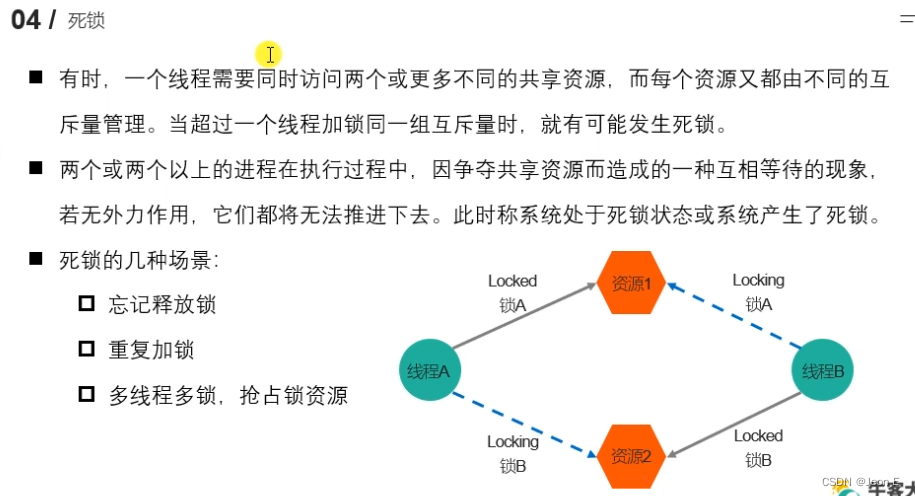
读写锁

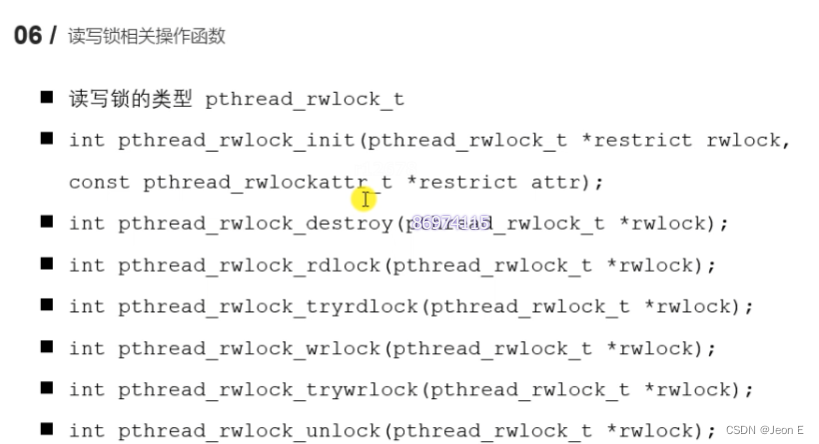
//读写锁类型 pthread_rwlock_t
int pthread_rwlock_init(pthread_rwlock_t *restrict rwlock, const pthread_rwlockattr_t *restrict attr);
int pthread_rwlock_destroy(pthread_rwlock_t *rwptr);
int pthread_rwlock_rdlock(pthread_rwlock_t *rwptr);
int pthread_rwlock_tryrdlock(pthread_rwlock_t *rwptr);
int pthread_rwlock_wrlock(pthread_rwlock_t *rwptr);
int pthread_rwlock_trywrlock(pthread_rwlock_t *rwptr);
int pthread_rwlock_unlock(pthread_rwlock_t *rwptr);
示例:
//创建8个线程,操作同一个全局变量
//3个线程不定时写全局变量,5个线程不定时读全局变量
#include<stdio.h>
#include<pthread.h>
#include<unistd.h>
//创建一个共享数据
int num=1;
pthread_rwlock_t rwlock;
void* writeNum(void* arg)
{
while(1)
{
pthread_rwlock_wrlock(&rwlock);
num++;
printf("++write, tid : %ld, num : %d\n",pthread_self(),num);
pthread_rwlock_unlock(&rwlock);
usleep(100);
}
return NULL;
}
void* readNum(void* arg)
{
while(1)
{
pthread_rwlock_rdlock(&rwlock);
printf("==read, tid : %ld, num : %d\n",pthread_self(),num);
pthread_rwlock_unlock(&rwlock);
usleep(100);
}
return NULL;
}
int main()
{
pthread_rwlock_init(&rwlock,NULL);
//创建3个写线程,5个读线程
pthread_t wtids[3],rtids[5];
for(int i=0;i<3;i++)
pthread_create(&wtids[i],NULL,writeNum,NULL);
for(int i=0;i<5;i++)
pthread_create(&rtids[i],NULL,readNum,NULL);
//设置线程分离
for(int i=0;i<3;i++)
pthread_detach(wtids[i]);
for(int i=0;i<5;i++)
pthread_detach(rtids[i]);
pthread_exit(NULL);
pthread_rwlock_destroy(&rwlock);
return 0;
}
生产者和消费者模型
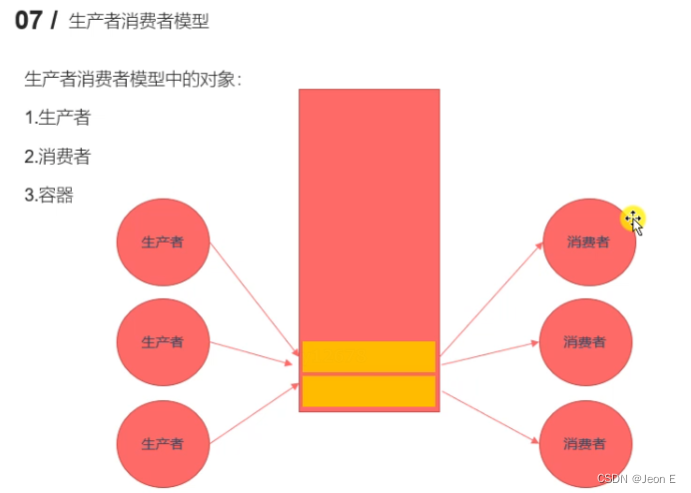
条件变量

示例:
//生产者消费者模型(粗略条件变量版本)
#include<stdio.h>
#include<pthread.h>
#include<stdlib.h>
#include<unistd.h>
//创建一个互斥量
pthread_mutex_t mutex;
//创建条件变量
pthread_cond_t cond;
struct Node
{
int num;
struct Node* next;
};
//头结点
struct Node* head=NULL;
void* producer(void* arg)
{
//不断创建新节点,添加到链表中
while(1)
{
pthread_mutex_lock(&mutex);
struct Node* newNode = (struct Node*)malloc(sizeof(struct Node));
newNode->next = head;
head = newNode;
newNode->num=rand()%1000;
printf("add node, num: %d , tid: %ld\n",newNode->num,pthread_self());
//只要生成一个,就通知消费者消费
pthread_cond_signal(&cond);
//signal通知一个或多个,broadcast广播全部通知
pthread_mutex_unlock(&mutex);
usleep(100);
}
return NULL;
}
void* customer(void* arg)
{
while(1)
{
pthread_mutex_lock(&mutex);
struct Node* tmp = head;
if(head != NULL)
{
head=head->next;
printf("del node, num: %d , tid: %ld\n",tmp->num,pthread_self());
free(tmp);
pthread_mutex_unlock(&mutex);
usleep(100);
}
else
{
//没有数据,需要等待
//当这个函数调用阻塞的时候,会先对互斥锁进行解锁,在解除阻塞时,会再加上锁
pthread_cond_wait(&cond,&mutex);
//当生产者生产,通知了,就解除阻塞
pthread_mutex_unlock(&mutex);
}
}
return NULL;
}
int main()
{
pthread_mutex_init(&mutex,NULL);
pthread_cond_init(&cond,NULL);
//创建5个生成者,5个消费者
pthread_t ptids[5],ctids[5];
for(int i=0;i<5;i++)
{
pthread_create(&ptids[i],NULL,producer,NULL);
pthread_create(&ctids[i],NULL,customer,NULL);
}
//线程分离
for(int i=0;i<5;i++)
{
pthread_detach(ptids[i]);
pthread_detach(ctids[i]);
}
while(1)
sleep(10);
pthread_cond_destroy(&cond);
pthread_mutex_destroy(&mutex);
pthread_exit(NULL);
return 0;
}
信号量
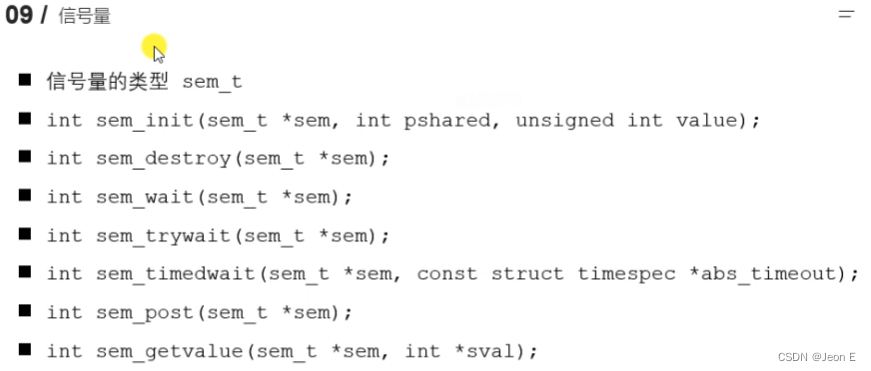
#include <semaphore.h>
int sem_init(sem_t *sem, int pshared, unsigned int value);
/*
初始化信号量
参数:
-sem:信号量变量的地址
-pshared:
-0:用在线程间
-非0:用在进程间
-value:信号量中的值
*/
int sem_destroy(sem_t *sem);
/*
释放资源
*/
int sem_wait(sem_t *sem);
/*
对信号量的值-1,如果值为0,就阻塞至大于0
*/
int sem_trywait(sem_t *sem);
int sem_timedwait(sem_t *sem, const struct timespec *abs_timeout);
int sem_post(sem_t *sem);
/*
对信号量解锁,调用一次,对信号量的值+1
*/
int sem_getvalue(sem_t *sem, int *sval);
示例:
//生产者消费者模型(信号量版本)
#include<stdio.h>
#include<pthread.h>
#include<stdlib.h>
#include<unistd.h>
#include<semaphore.h>
//创建一个互斥量
pthread_mutex_t mutex;
//创建两个信号量
sem_t psem;
sem_t csem;
struct Node
{
int num;
struct Node* next;
};
//头结点
struct Node* head=NULL;
void* producer(void* arg)
{
//不断创建新节点,添加到链表中
while(1)
{
sem_wait(&psem);
pthread_mutex_lock(&mutex);
struct Node* newNode = (struct Node*)malloc(sizeof(struct Node));
newNode->next = head;
head = newNode;
newNode->num=rand()%1000;
printf("add node, num: %d , tid: %ld\n",newNode->num,pthread_self());
pthread_mutex_unlock(&mutex);
sem_post(&csem);
}
return NULL;
}
void* customer(void* arg)
{
while(1)
{
sem_wait(&csem);
pthread_mutex_lock(&mutex);
struct Node* tmp = head;
head=head->next;
printf("del node, num: %d , tid: %ld\n",tmp->num,pthread_self());
free(tmp);
pthread_mutex_unlock(&mutex);
sem_post(&psem);
}
return NULL;
}
int main()
{
pthread_mutex_init(&mutex,NULL);
sem_init(&psem,0,8);
sem_init(&csem,0,0);
//创建5个生成者,5个消费者
pthread_t ptids[5],ctids[5];
for(int i=0;i<5;i++)
{
pthread_create(&ptids[i],NULL,producer,NULL);
pthread_create(&ctids[i],NULL,customer,NULL);
}
//线程分离
for(int i=0;i<5;i++)
{
pthread_detach(ptids[i]);
pthread_detach(ctids[i]);
}
while(1)
sleep(10);
pthread_mutex_destroy(&mutex);
pthread_exit(NULL);
return 0;
}























 被折叠的 条评论
为什么被折叠?
被折叠的 条评论
为什么被折叠?








